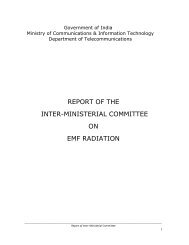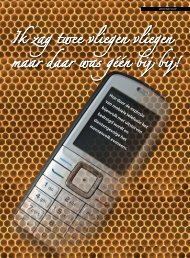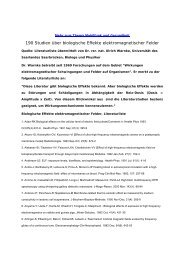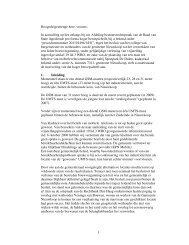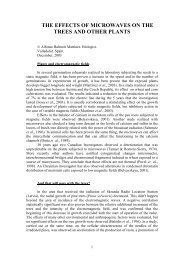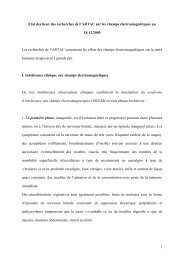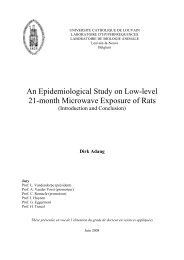Impacts of radio-frequency electromagnetic field (RF-EMF) from cell ...
Impacts of radio-frequency electromagnetic field (RF-EMF) from cell ...
Impacts of radio-frequency electromagnetic field (RF-EMF) from cell ...
Create successful ePaper yourself
Turn your PDF publications into a flip-book with our unique Google optimized e-Paper software.
Review Article Biology and Medicine, 4 (4): 202–216, 2012FCC, 1999). The <strong>electromagnetic</strong> radiations are<strong>of</strong> two types, one being ionizing radiations suchas X-rays and gamma rays, and the other beingnon-ionizing radiations such as electric andmagnetic <strong>field</strong>s, <strong>radio</strong> waves, <strong>radio</strong>- <strong>frequency</strong>band which includes microwaves, infrared,ultraviolet, and visible radiation (Figure 1).The biological effects <strong>of</strong> <strong>RF</strong>-<strong>EMF</strong> at molecularlevel induce thermal and non-thermal damage,which may be due to dielectric heating leadingto protein denaturation, polar molecular agitation,<strong>cell</strong>ular response through molecular cascadesand heat shock proteins, and changesin enzyme kinetics in <strong>cell</strong>s (Instituto Edumed,2010). The three major physical parameters <strong>of</strong><strong>RF</strong>-<strong>EMF</strong> radiations is <strong>frequency</strong>, intensity, andexposure duration. Although the non-ionizingradiations are considered less dangerous thanionizing radiation, over-exposure can causehealth hazards (FCC, 1999).Electromagnetic Spectrum and <strong>RF</strong>-<strong>EMF</strong> RadiationThe <strong>RF</strong>-<strong>EMF</strong> radiations fall in the range <strong>of</strong>10 MHz–300 GHz. Cell phone technology usesfrequencies mainly between 800 MHz and 3 GHzand <strong>cell</strong> tower antenna uses a <strong>frequency</strong> <strong>of</strong> 900or 1800 MHz, pulsed at low frequencies, generallyknown as microwaves (300 MHz–300 GHz).Power Density and Specific Absorption Rate(SAR)Variables used in the measurement <strong>of</strong> theseradiations are power density, measured in wattsper meter squared (W/m 2 ) and specific absorptionRate (SAR). The term used to describe theabsorption <strong>of</strong> <strong>RF</strong>-<strong>EMF</strong> radiation in the body isSAR, which is the rate <strong>of</strong> energy that is actuallyabsorbed by a unit <strong>of</strong> tissue, expressed inwatts per kilogram (W/kg) <strong>of</strong> tissue. The SARmeasurements are averaged either over thewhole body or over a small volume <strong>of</strong> tissue,typically between 1 and 10 g <strong>of</strong> tissue. SARwas set with the help <strong>of</strong> a phantom, known asspecific anthropomorphic mannequin (SAM)derived <strong>from</strong> the size and dimensions <strong>of</strong> the90th percentile large adult male reported in a1988 US Army study who is 6 feet 2 inchesand weighed 200 pounds (Davis, 2010). SARis set at 1.6 W/kg averaged over 1 g <strong>of</strong> bodytissue in the US and Canada and 2 W/kgaveraged over 10 g <strong>of</strong> body tissue in countriesadopting the ICNIRP guidelines. The SAR isused to quantify energy absorption to <strong>field</strong>s typicallybetween 100 kHz and 10 GHz and encompasses<strong>radio</strong>-<strong>frequency</strong> radiation <strong>from</strong> devicessuch as <strong>cell</strong>ular phones up through diagnosticmagnetic resonance imaging (MRI). The biologicaleffects depend on how much <strong>of</strong> the energyNon-ionizingIonizingRadio-frequenciesVisiblelightPower linesRadio andMicrowaves Infrared UltraviolettelevisionCellular <strong>radio</strong>X-raysGamma raysFrequency (Hz)10 10 210 3 10 4 10 5 10 6 10 7 10 8 10 9 10 10 10 11 10 12 10 13 10 14 10 15 10 16 10 17 10 18 10 19 10 20 10 21 10 22 10 23 10 24 10 25 10 26Energy (eV)10 −13 10 −12 10 −11 10 −10 10 −9 10 −8 10 −7 10 −6 10 −5 10 −4 10 −3 10 −2 0.1 1 10 10 2 10 3 10 4 10 5 10 6 10 7 10 8 10 9 10 10 10 11Figure 1: Electromagnetic spectrum <strong>from</strong> the Federal Communications Commission (FCC), OETBulletin 56, 1999.BMID: BM-8 203
Review Article Biology and Medicine, 4 (4): 202–216, 2012and proteomics as high-throughput screeningtechniques (HTSTs), were eventually employed in<strong>EMF</strong> research with an intention to screen potential<strong>EMF</strong> responsive genes and/or proteins withoutany bias (Nylund and Leszczynski, 2004).The safety standards set by ICNIRP, adopted byIndia, has only taken into account the short-termeffects and not against the biological effects <strong>from</strong>long-term, non-thermal, low-level microwaveexposure <strong>from</strong> mobile phones, <strong>cell</strong> phone towers,and many other wireless devices.Current ResearchVarious studies have shown that even at lowlevels <strong>of</strong> this radiation, there is evidence <strong>of</strong> damageto <strong>cell</strong> tissue and DNA, and it has been linkedto brain tumors, cancer, suppressed immunefunction, neuroendocrine disruption, chronicfatigue syndrome, and depression (Rogers, 2002;Milham, 2010). Oncogenesis studies at molecularand <strong>cell</strong>ular levels due to <strong>RF</strong>-<strong>EMF</strong> radiationsare considered particularly important (Marinoand Carrubba, 2009). Orientation, navigation,and homing are critical traits expressed byorganisms ranging <strong>from</strong> bacteria through highervertebrates. Across many species and groups <strong>of</strong>organisms, compelling evidence exists that thephysical basis <strong>of</strong> this response is tiny crystals<strong>of</strong> single-domain magnetite (Fe 3O 4) (Kirschvinket al., 2001). All magnetic <strong>field</strong> sensitivity in livingorganisms, including elasmobranch fishes,is the result <strong>of</strong> a highly evolved, finely-tunedsensory system based on single-domain, ferromagneticcrystals. Animals that depend on thenatural electrical, magnetic, and <strong>electromagnetic</strong><strong>field</strong>s for their orientation and navigation throughearth’s atmosphere are confused by the muchstronger and constantly changing artificial <strong>field</strong>screated by technology and fail to navigate backto their home environments (Warnke, 2007).Studies on PlantsTops <strong>of</strong> trees tend to dry up when they directlyface the <strong>cell</strong> tower antennas and they seem tobe most vulnerable if they have their roots closeto the water (Belyavskaya, 2004). They also havea gloomy and unhealthy appearance, possiblegrowth delays, and a higher tendency to contractplagues and illnesses. According to Levitt(2010), trees, algae, and other vegetation mayalso be affected by <strong>RF</strong>-<strong>EMF</strong>. Some studies havefound both growth stimulation and dieback.The browning <strong>of</strong> tree tops is <strong>of</strong>ten observednear <strong>cell</strong> towers, especially when water is neartheir root base. The tree tops are known as <strong>RF</strong>waveguides. In fact, military applications utilizethis capability in trees for low-flying weapon systems.In an observational study, it was found thatthe output <strong>of</strong> most fruit-bearing trees reduceddrastically <strong>from</strong> 100% to ,5% after 2.5 years <strong>of</strong><strong>cell</strong> tower installation in a farm facing four <strong>cell</strong>towers in Gurgaon–Delhi Toll Naka (Kumar andKumar, 2009).Studies on InsectsMonarch butterflies and locusts migrate greatdistances using their antennae to sense air currentsand earths <strong>electromagnetic</strong> <strong>field</strong>s. Mothsare drawn to light frequencies. Ants, with the help<strong>of</strong> their antennas are adept at electrical transmissionand found to respond to frequencies as lowas 9 MHz. Flying ants are very sensitive to <strong>electromagnetic</strong><strong>field</strong>s (Warnke, 2007).Bees have clusters <strong>of</strong> magnetite in theabdominal areas. colony collapse disorder (CCD)was observed in beehives exposed to 900 MHzfor 10 minutes, with sudden disappearance <strong>of</strong>a hive’s inhabitants, leaving only queen, eggs,and a few immature workers behind. With navigationalskills affected, worker bees stoppedcoming to the hives after 10 days and egg productionin queen bees dropped drastically to100 eggs/day compared to 350 eggs (Sharma andKumar, 2010). Radiation affects the pollinators,honeybees, whose numbers have recently beendeclining due to CCD by 60% at US West Coastapiaries and 70% along the East Coast (Caneand Tepedino, 2001). CCD is being documentedin Greece, Italy, Germany, Portugal, Spain, andSwitzerland. Studies performed in Europe documentednavigational disorientation, lower honeyproduction, and decreased bee survivorship(Kimmel et al., 2007). <strong>EMF</strong>s <strong>from</strong> telecommunicationinfrastructure interfere with bees’ biologicalclocks that enable them to compensate properlyfor the sun’s movements, as a result <strong>of</strong> which,may fly in the wrong direction when attemptingto return to the hive (Rubin et al., 2006). Bee coloniesirradiated with digital enhanced cordlesscommunications (DECT) phones and mobilehandsets had a dramatic impact on the behavior<strong>of</strong> the bees, namely by inducing the workerBMID: BM-8 206
Review Article Biology and Medicine, 4 (4): 202–216, 2012piping signal. In natural conditions, worker pipingeither announces the swarming process <strong>of</strong>the bee colony or is a signal <strong>of</strong> a disturbed beecolony (Favre, 2011).A study by the University <strong>of</strong> Athens onfruit flies exposed to 6 minutes <strong>of</strong> 900 MHz pulsedradiation for 5 days showed reduction in reproductivecapacity (Panagopoulos et al., 2004).Likewise in 2007, in both 900 and 1800 MHz,similar changes in reproductive capacity with nosignificant difference between the two frequencieswere observed (Panagopoulos et al., 2007).In a third study, it was found it was due degeneration<strong>of</strong> large numbers <strong>of</strong> egg chambers afterDNA fragmentation (Panagopoulos et al., 2010).When Drosophila melanogaster adult insectswere exposed to the radiation <strong>of</strong> a GSM 900/1800mobile phone antenna at different distances ranging<strong>from</strong> 0 to 100 cm, these radiations decreasedthe reproductive capacity by <strong>cell</strong> death inductionat all distances tested (Levengood, 1969).Studies on Amphibians and ReptilesSalamanders and turtles have navigational abilitiesbased on magnetic sensing as well as smell.Many species <strong>of</strong> frogs have disappeared allover the world in the last 3–5 years. Amphibianscan be especially sensitive because their skinis always moist, and they live close to, or inwater, which conducts electricity easily (Hotaryand Robinson, 1994). Toads when exposed to1425 MHz at a power density <strong>of</strong> 0.6 mW/cm 2developed arrhythmia (Levitina, 1966). Increasedmortality and induced deformities were notedin frog tadpoles (Rana temporaria) (Levengood,1969). It was observed that experimental tadpolesdeveloped more slowly, less synchronouslythan control tadpoles, remain at the earlystages for a longer time, developed allergies andthat <strong>EMF</strong> causes changes in the blood counts(Grefner et al., 1998). In a two-month study inSpain in common frog tadpoles on the effects<strong>of</strong> mobile phone mast located at a distance <strong>of</strong>140 m noted low coordination <strong>of</strong> movements,an asynchronous growth, resulting in both bigand small tadpoles, and a high mortality (90%)in exposed group. For the unexposed group inFaraday cage, the coordination <strong>of</strong> movementswas normal, the development was synchronous,and a mortality <strong>of</strong> 4.2% was obtained (Balmori,2009). In the eggs and embryos <strong>of</strong> Rana sylvaticaand Ambystoma maculatum abnormalities atseveral developmental stages were noted suchas microcephalia, scoliosis, edema, and retardedgrowth. Tadpoles developed severe leg malformationsand extra legs, as well as a pronouncedalteration <strong>of</strong> histogenesis which took the form <strong>of</strong>subepidermal blistering and edema. Effects werenoted in reproduction, circulatory, and centralnervous system, general health and well being(Balmori, 2010; Balmori, 2005).Studies on BirdsA study by the Centre for Environment andVocational Studies <strong>of</strong> Punjab University noted thatembryos <strong>of</strong> 50 eggs <strong>of</strong> house sparrows were damagedafter being exposed to mobile tower radiationfor 5–30 minutes (MOEF, 2010). Observedchanges included reproductive and coordinationproblems and aggressiveness. Tower-emittedmicrowave radiation affected bird breeding, nesting,and roosting in Valladolid, Spain (US Fish &Wildlife Service, 2009). House sparrows, whitestorks, rock doves, magpies, collared dovesexhibited nest and site abandonment, plumagedeterioration (lack <strong>of</strong> shine, beardless rachis, etc.),locomotion problems, and even death amongsome birds. No symptoms were observed prior toconstruction <strong>of</strong> the <strong>cell</strong> phone towers. Accordingto Balmori, plumage deterioration and damagedfeather are the first signs <strong>of</strong> weakening, illnesses,or stress in birds. The disappearance <strong>of</strong> insects,leading to lack <strong>of</strong> food, could have an influenceon bird’s weakening, especially at the first stagesin young bird’s life. In chick embryos exposed toELF pulsed EMR, a potent teratogenic effect wasobserved, leading to microphthalmia, abnormaltrunkal torsion, and malformations on the neuraltube (Lahijani and Ghafoori, 2000).White storks were heavily impacted bythe tower radiation during the 2002–2004 nestingseason in Spain. Evidence <strong>of</strong> a connectionbetween sparrow decline in UK and theintroduction <strong>of</strong> phone mast GSM was established(Balmori, 2009). In a study in Spain, theeffects <strong>of</strong> mobile phone mast has been notedin house sparrow (Passer domesticus), whitestork (Ciconia ciconia), reporting problems withreproduction, circulatory, and central nervoussystem, general health and well-being (microwavesyndrome) (Balmori, 2009). Deformitiesand deaths were noted in the domestic chickenembryos subjected to low-level, non-thermalradiation <strong>from</strong> the standard 915 MHz <strong>cell</strong> phoneBMID: BM-8 207
Review Article Biology and Medicine, 4 (4): 202–216, 2012The most affected <strong>of</strong> the species arebees, birds, and bats and without these pollinatorsvisiting flowers, 33% <strong>of</strong> fruits and vegetableswould not exist, and as the number <strong>of</strong>pollinators decline, the agricultural crops will fallshort and the price <strong>of</strong> groceries will go up (Kevanand Phillips, 2001).Studies on HumansThe exposure to continuous <strong>RF</strong>-<strong>EMF</strong> radiationposes a greater risk to children, particularly dueto their thinner skulls and rapid rate <strong>of</strong> growth.Also at risk are the elderly, the frail, and pregnantwomen (Cherry, 2001). DNA damage viafree radical formation inside <strong>cell</strong>s has also beenrecorded (Lai and Singh, 1996). Free radicalskill <strong>cell</strong>s by damaging macromolecules such asDNA, protein, and membrane are carcinogenic.In fact, EMR enhances free radical activity.Single- and double-strand DNA breaks are seenin rat brain <strong>cell</strong>s after acute exposure to radi<strong>of</strong>requency<strong>electromagnetic</strong> radiation. Kane (2001)denotes that <strong>RF</strong>-<strong>EMF</strong> radiations lead to tissuedamage, DNA damage, or chromosome mutations.In 2008, the Austrian Department <strong>of</strong> Healthfound a higher risk <strong>of</strong> cancer among people livingwithin 200 m <strong>of</strong> a mobile phone base station andthat cancer risk rose with increasing exposure,reaching 8.5 times the norm for people mostexposed. From a study on in vitro <strong>cell</strong> responseto mobile phone radiation (900 MHz GSM signal)using two variants <strong>of</strong> human endothelial <strong>cell</strong>line, it was suggested that the <strong>cell</strong> response tomobile phone radiation might be genome- andproteome-dependent. Therefore, it is likely thatdifferent types <strong>of</strong> <strong>cell</strong>s and <strong>from</strong> different speciesmight respond differently to mobile phoneradiation or might have different sensitivity to thisweak stimulus (Nylund and Leszczynski, 2006).The results <strong>of</strong> the interphone, an internationalcase–control study to assess the braintumor risk in relation to mobile telephone use,reveals no overall increase in risk <strong>of</strong> glioma ormeningioma but there were suggestions <strong>of</strong> anincreased risk <strong>of</strong> glioma at the highest exposurelevels (30 minutes per day <strong>of</strong> <strong>cell</strong> phone use for8–10 years) and ipsilateral exposures (ICNIRP,2011). Children and young adults were excluded<strong>from</strong> the study and a separate study called Mobi-Kids is underway. According to Santini et al.(2002), comparisons <strong>of</strong> complaints in relationwith distance <strong>from</strong> base station show significantincrease as compared to people living greaterthan 300 m or not exposed to base station, till300 m for tiredness, 200 m for headache, sleepdisturbance, and discomfort, and 100 m for irritability,depression, loss <strong>of</strong> memory, dizziness, andlibido decrease. Women significantly more <strong>of</strong>tenthan men complained <strong>of</strong> headache, nausea, loss<strong>of</strong> appetite, sleep disturbance, depression, discomfort,and visual perturbations (Santini et al.,2002). According to Oberfeld et al. (2004) in Spain,a follow-up study found that the most exposedpeople had a higher incidence <strong>of</strong> fatigue, irritability,headaches, nausea, loss <strong>of</strong> appetite, sleepingdisorders, depression, discomfort, difficultiesconcentrating, memory loss, visual disorders,dizziness, and cardiovascular problems. Womenare more at risk as they tend to spend more timeat home and are exposed to radiation continuously.The authors recommended a maximumexposure <strong>of</strong> 0.0001 µW/cm 2 or 0.000001 W/m 2 .There was prevalence <strong>of</strong> neuropsychiatric complaintsamong people living near base stations(Abdel-Rassoul et al., 2007). Urban <strong>electromagnetic</strong>contamination (electrosmog) 900 and1800 MHz pulsated waves interfere in the nervoussystem <strong>of</strong> living beings (Hyland, 2000). Growingamounts <strong>of</strong> published research show adverseeffects on both humans and wildlife far below athermal threshold, usually referred to as “non-thermaleffects”, especially under conditions <strong>of</strong> longterm,low-level exposure (Levitt and Lai, 2010).Australian research conducted by DeIuliis et al. (2009) by subjecting in vitro samples<strong>of</strong> human spermatozoa to <strong>radio</strong>-<strong>frequency</strong>radiation at 1.8 GHz and SAR <strong>of</strong> 0.4–27.5 W/kgshowed a correlation between increasing SAR anddecreased motility and vitality in sperm, increasedoxidative stress and 8-Oxo-2-deoxyguanosinemarkers, stimulating DNA base adduct formationand increased DNA fragmentation. GSM mobilephone exposure can activate <strong>cell</strong>ular stressresponse in both humans and animal <strong>cell</strong>s andcause the <strong>cell</strong>s to produce heat shock proteins(HSP27 and HSP70) (Leszczynski, 2002). HSPsinhibit natural programmed <strong>cell</strong> death (apoptosis),whereby <strong>cell</strong>s that should have committed suicidecontinue to live. Recent studies have shown thatthese HSPs inhibit apoptosis in cancer <strong>cell</strong>s. Inseveral cases, melatonin hormone which controlsthe daily biological cycle and has an oncostaticaction, produced by the epiphysis (pineal gland)in mammals, mainly during the night, is found toreduce the action <strong>of</strong> EMR exposure, but the synthesis<strong>of</strong> melatonin itself seems to be reducedBMID: BM-8 209
Review Article Biology and Medicine, 4 (4): 202–216, 2012by EMR (Panagopoulos et al., 2008). In a studyto observe the effects <strong>of</strong> melatonin in hormonebalance in a diabetic, it was found that melatonincaused reduction in serum insulin, serum cortisol,serum ACTH, and serum TSH levels while increasein serum gastrin level. Of the biochemical parameters,melatonin caused reductions in TLC, LDLC,and FBS while increase in HDLC. It also causedreduction in neutrophil and increase in lymphocytecount in a diabetic with increase in faecal fat excretion(Mitra and Bhattacharya, 2008).<strong>RF</strong>-EMR produces DNA damage viafree radical formation inside <strong>cell</strong>s. Free radicalskill <strong>cell</strong>s by damaging macromolecules such asDNA, protein, and membrane, also shown to becarcinogenic. EMR enhances free radical activity.EMR interferes with navigational equipments, lifelineelectronic gadgets in hospitals, and affectspatients with pacemakers. A short-term exposure(15 and 30 minutes) to <strong>RF</strong>R (900 MHz) <strong>from</strong>a mobile phone caused a significant increasein DNA single strand breaks in human hair root<strong>cell</strong>s located around the ear which is used for thephone calls (Çam and Seyhan, 2012). Various invitro studies have shown that 1800 MHz <strong>RF</strong>-<strong>EMF</strong>radiation could cause oxidative damage tomtDNA in primary cultured neurons. Oxidativedamage to mtDNA may account for the neurotoxicity<strong>of</strong> <strong>RF</strong> radiation in the brain (Xu et al., 2010).Studies carried out on the <strong>RF</strong> levelsin North India, particularly at the mobile towersites at Delhi have shown that people in Indiancities are exposed to dangerously high levels<strong>of</strong> <strong>EMF</strong> pollution (Tanwar, 2006). An independentstudy was commissioned by the CellularOperators Association <strong>of</strong> India (COAI) andAssociation <strong>of</strong> Unified Telecom Service Providers<strong>of</strong> India (AUSPI) as a proactive measure stemming<strong>from</strong> the concern for the public healthand safety issues on <strong>electromagnetic</strong> radiationmeasurement at New Delhi showed compliancewith ICNIRP standards. 180 areas were studiedacross the capital to understand the extent<strong>of</strong> <strong>RF</strong>-<strong>EMF</strong> radiations emitting <strong>from</strong> the mobiletowers, revealed that the readings were 100times below international safety guidelines. Thestudy measured cumulative emissions within the800–2000 MHz band <strong>of</strong> <strong>frequency</strong> (which includesboth GSM and CDMA technologies) across in thenation’s capital using carefully calibrated equipment,as per the DoT prescribed procedure in linewith the ICNIRP specifications. In a similar, butindependent case study in Mumbai, it was foundthat people living within 50–300 m radius are inthe high radiation zone and are more prone to illeffects<strong>of</strong> <strong>electromagnetic</strong> radiation. Four cases<strong>of</strong> cancer were found in three consecutive floors(6th, 7th, 8th) directly facing and at similar heightas four mobile phone towers placed at the ro<strong>of</strong> <strong>of</strong>the opposite building (Kumar, 2010). According tothe Seletun Scientific Statement (2011), low-intensity(non-thermal) bioeffects and adverse healtheffects are demonstrated at levels significantlybelow existing exposure standards. ICNIRP/WHOand IEEE/FCC public safety limits are inadequateand obsolete with respect to prolonged, low-intensityexposures (New International <strong>EMF</strong> Alliance,2011). New, biologically-based public exposurestandards are urgently needed to protect publichealth world-wide. EMR exposures should bereduced now rather than waiting for pro<strong>of</strong> <strong>of</strong> harmbefore acting (Fragopoulou et al., 2010).Electrohypersensitivity (EHS) andElectromagnetic Field Intolerance (EFI)SyndromeElectrosensitivity <strong>of</strong> people is now recognizedas a physical impairment by government healthauthorities in the United Kingdom and Sweden.The UK Health Protection Agency (HPA) recognizedthat people can suffer nausea, headaches,and muscle pains when exposed to <strong>electromagnetic</strong><strong>field</strong>s <strong>from</strong> mobile phones, electricity pylons,and computer screens. A case study in Sweden,one <strong>of</strong> the first countries were mobile technologywas introduced approximately 15 years ago,shows that 250,000 Swedes are allergic to mobilephone radiation. Sweden has now recognizedEHS as a physical degradation and EHS sufferersare entitled to have metal shielding installed intheir homes free <strong>of</strong> charge <strong>from</strong> the local government(Kumar, 2010; Johansson, 2010).Belpomme (2011) in his presentation atthe 8th National Congress on Electrosmog inBerne in 2011 elaborates on the dangers <strong>of</strong> wirelesstechnology and the diagnostics and treatment<strong>of</strong> the <strong>electromagnetic</strong> <strong>field</strong> intolerance (EFI)Syndrome. In his study <strong>from</strong> 2008 to 2011, thepatients with EHS were investigated with a pulseequilibrium brain scan, dosage <strong>of</strong> histamine in theblood, dosage <strong>of</strong> the heat shock proteins HSP70and HSP27, and appearance and disappearance<strong>of</strong> symptoms on exposure to an <strong>electromagnetic</strong><strong>field</strong> source. Diagnosis <strong>of</strong> fatigue and depressionwere noted. The physiological changessuch as vitamin D deficiency, decrease in heatBMID: BM-8 210
Review Article Biology and Medicine, 4 (4): 202–216, 2012shock proteins, increase in histamines, increasein biomarker <strong>of</strong> the opening <strong>of</strong> blood-brain barrier,protein S100P, decrease in urinary melatonin,and increase in blood anti-myelin proteins werenoted in the electrosensitives. Around 50% <strong>of</strong> thepatients in the study had used a mobile phone formore than one hour per day during several yearsand his findings were similar to the figures publishedby Hardell’s study (2007) dealing with thecancer occurrences and <strong>electromagnetic</strong> <strong>field</strong>s.Future Challenges and SolutionsResearch into the advantages <strong>of</strong> <strong>radio</strong>-<strong>frequency</strong>energies seen in tissue heating in benign prostatichyperplasia (BPH), electrical therapy for cardiacarrhythmia, <strong>radio</strong>-<strong>frequency</strong> ablation, use <strong>of</strong> 41.5–44.58C temperature to kill tumors, shortwave andmicrowave diathermy for musculoskeletal injuries,and microwave oven used in food preparation areall carried out under controlled conditions. Buteffects, if any, <strong>from</strong> <strong>RF</strong>-<strong>EMF</strong> radiations releasedinto the environment over a long period <strong>of</strong> time indensely populated areas where people are continuouslyexposed to them will show in years tocome. According to Osepchuk (1983), frequenciesused in industrial, scientific, and medical heatingprocesses are 27.12, 40.68, 433, 915, 2450, and5800 MHz. Out <strong>of</strong> which, for diathermy, frequenciesused are 27.12, 915, and 2450 MHz in US and433 MHz is authorized in Europe. According toKasevich (2000), “the physics <strong>of</strong> <strong>electromagnetic</strong>waves and their interactions with material and biologicalsystems is based on the concept that the<strong>electromagnetic</strong> wave is a force <strong>field</strong> which exerts amechanical torque, pressure or force on electricallychanged molecules. All living things contain thesedielectric properties. The thermal effects producedby absorption <strong>of</strong> <strong>electromagnetic</strong> energy are thedirect result <strong>of</strong> water molecules acted upon bythe oscillating electric <strong>field</strong>, rubbing against eachother to produce electric heat (thermal effects)”.Research work on <strong>electromagnetic</strong> bioeffects inhumans and animals in the non-thermal range iscontinuing where effects are noted even at intensitieslower than 1 mW/m 2 (0.001 W/m 2 or 1000 µW/m 2 , 0.0001 mW/cm 2 or 0.1 µW/cm 2 ).According to Levitt (2007), adverse outcomes<strong>of</strong> pregnancy can be mutagenic, teratogenic,oncogenic or carcinogenic, and ionizingradiations can cause all three. In animal studies,non-ionizing radiation was also found to be teratogenicand oncogenic, and likely mutagenic, butit is unclear if these observations were due toheating affect, non-thermal affects or both. Trees,plants, soil, grass, and shrubs have the abilityto absorb <strong>electromagnetic</strong> wave energy over avery broad range <strong>of</strong> wavelengths. According tothe resonance concept, human beings can act asreceiving antennas for some frequencies, wherethe absorbed energy is maximized in some areas<strong>of</strong> the body, like the brain (Levitt, 2007).In the Bioinitiative Report, a documentprepared by 14 international experts in a ninemonthproject, in which over 2000 scientific studieswere reviewed, Sage (2007) came to a conclusionthat there may be no lower limit that may be safe,and there was a need for biologically-based limits(1 mW/m 2 or 0.001 W/m 2 ) and children are atmost risk. Safety limits suggested are 0.001 W/m 2for outdoor cumulative <strong>radio</strong>-<strong>frequency</strong> exposureand 0.0001 W/m 2 for indoor, cumulative radi<strong>of</strong>requencyexposure. According to Blank (2012),there is a need for a realistic biological standard toreplace the thermal (SAR) standard. The precautionaryapproaches includes prudence avoidancefor public and ALARA, which stands for “as lowas reasonably attainable” for regulatory agencies.According to Havas (2006), several disorders,including asthma, ADD/ADHD, diabetes,multiple sclerosis, chronic fatigue, fibromyalgia,are increasing at an alarming rate, as is <strong>electromagnetic</strong>pollution in the form <strong>of</strong> dirty electricity,ground current, and <strong>radio</strong>-<strong>frequency</strong> radiation<strong>from</strong> wireless devices and the connection between<strong>electromagnetic</strong> pollution and these disordersneeds to be investigated and the percentage <strong>of</strong>people sensitive to this form <strong>of</strong> energy needs tobe determined. According to Milham (2010), 20thcentury epidemic <strong>of</strong> the so-called diseases <strong>of</strong> civilization,including cardiovascular disease, cancer,diabetes, and also suicides, was caused by electrificationand the unique biological responseswe have to it and that our evolutionary balance,developed over the millennia has been severelydisturbed and disrupted by man-made <strong>EMF</strong>s.ConclusionThe Department <strong>of</strong> Telecommunication (DoT)in India has set new norms for <strong>cell</strong> phone towerswith effect <strong>from</strong> September 1, 2012 (TheHindu, 2012). Exposure standards for <strong>RF</strong>-<strong>EMF</strong>radiation has been reduced to one-tenth <strong>of</strong> theexisting level and SAR <strong>from</strong> 2 to 1.6 W/kg. Thiscame after the ministry <strong>of</strong> environment and forestBMID: BM-8 211
Review Article Biology and Medicine, 4 (4): 202–216, 2012HumanOther animalsPlantsWildlifeBeesBirds0%10% 20% 30% 40% 50% 60% 70% 80% 90% 100%Impact No impact InconclusiveFigure 2: Percentage <strong>of</strong> studies that reported harmful effect <strong>of</strong> EMR in various groups <strong>of</strong> organisms(n 5 919), MOEF Report (2010).(MOEF) set up an Inter-ministerial Committee(IMC) to study the effects <strong>of</strong> <strong>RF</strong>-<strong>EMF</strong> radiationson wildlife (Figure 2) and concluded that out<strong>of</strong> the 919 research papers collected on birds,bees, plants, other animals, and humans, 593showed impacts, 180 showed no impacts, and196 were inconclusive studies. They concludethat there are no long-term data available on theenvironmental impacts <strong>of</strong> <strong>RF</strong>-<strong>EMF</strong> radiations inIndia. The population <strong>of</strong> India is increasing aswell as the <strong>cell</strong> phone subscribers and the <strong>cell</strong>towers as supporting infrastructure. Hence, thereis an urgent need to fill the gaps and do furtherresearch in this <strong>field</strong> with emphasis on the effects<strong>of</strong> early life and prenatal <strong>RF</strong>-<strong>EMF</strong> radiation exposurein animals, dosimetry studies, <strong>cell</strong>ular studiesusing more sensitive methods, and humanepidemiological studies, especially on childrenand young adults on behavioral and neurologicaldisorders and cancer. Meanwhile, one can takethe precautionary principle approach and reduce<strong>RF</strong>-<strong>EMF</strong> radiation effects <strong>of</strong> <strong>cell</strong> phone towers byrelocating towers away <strong>from</strong> densely populatedareas, increasing height <strong>of</strong> towers or changingthe direction <strong>of</strong> the antenna.ReferencesAbdel-Rassoul G, El-Fateh OA, Salem MA, Michael A,Farahat F, EI-Batanouny M, et al., 2007. Neurobehavioraleffects among inhabitants around mobile phone basestations. Neurotoxicology, 28(2): 434–440.ARPANSA, 2011. Introduction to radiation basics.http://www.arpansa.gov.au/RadiationProtection/basics/index.cfmBalmori A, 2003. The effects <strong>of</strong> microwave radiationon the wildlife. Preliminary results, Valladolid (Spain).http://www.whale.to/b/martinez.pdfBalmori A, 2005. Possible effects <strong>of</strong> <strong>electromagnetic</strong><strong>field</strong>s <strong>from</strong> phone masts on a population <strong>of</strong> whitestork (Ciconia ciconia). Electromagnetic Biology andMedicine, 24: 109–119.Balmori A, 2009. Electromagnetic pollution <strong>from</strong> phonemasts. Effects on wildlife. Pathophysiology, 16(2):191–199. DOI: 10.1016/j.pathophys.2009.01.007Balmori A, 2010. Mobile phone masts effects oncommon frog (Rana temporaria) tadpoles: the cityturned into a laboratory. Electromagnetic Biology andMedicine, 29: 31–35.Barnes FS, Greenebaum B, 2007. Handbook <strong>of</strong> biologicaleffects <strong>of</strong> <strong>electromagnetic</strong> <strong>field</strong>s: bioengineering andbiophysical aspects <strong>of</strong> <strong>electromagnetic</strong> <strong>field</strong>s. 3rdEdition, Boca Raton, FL: CRC Taylor and FrancisPress, 440.Beason RC, Semm P, 2002. Responses <strong>of</strong> neuronsto an amplitude modulated microwave stimulus.Neuroscience Letters, 333: 175–178.Belpomme D, 2011. Presentation <strong>of</strong> Pr<strong>of</strong>. DominiqueBelpomme at 8th National Congress on Electrosmog,Berne. http://citizensforsafetechnology.org/uploads/scribd/Presentation%20<strong>of</strong>%20Pr<strong>of</strong>.pdfBMID: BM-8 212
Review Article Biology and Medicine, 4 (4): 202–216, 2012Belyaev IY, Koch CB, Terenius O, Roxström-Lindquist K,Malmgren LO, Sommer W, et al., 2006. Exposure<strong>of</strong> rat brain to 915 MHz GSM microwaves induceschanges in gene expression but not double strandedDNA breaks or effects on chromatin conformation.Bio<strong>electromagnetic</strong>s, 27(4): 295–306.Belyavskaya NA, 2004. Biological effects due toweak magnetic <strong>field</strong> on plants. Advances in SpaceResearch, 34(7): 1566–1574.Birenbaum L, Gros<strong>of</strong> GM, Rosenthal SW, ZaretMM, 1969. Effect <strong>of</strong> microwaves on the eye. IEEETransactions on Biomedical Engineering, 16(1): 7–14.Blank M, 2012. Cell Towers and Cancer – BioinitiativeReport. http://www.youtube.com/watch?v5a6wLFeIrCtU&feature5related; www.weepinitiative.orgBusiness Standard, 2010. Cellular tower studydebunks radiation myth by COAI, AUSPI. December21, 2010. http://www.business-standard.com/india/news/<strong>cell</strong>ular-tower-study-debunks-radiation-mythby-coai-auspi/419036Çam ST, Seyhan N, 2012. Single -strand DNA breaksin human hair root <strong>cell</strong>s exposed to mobile phoneradiation. International Journal <strong>of</strong> Radiation Biology,88(5): 420–424.Cane JH, Tepedino VJ, 2001. Causes and extent <strong>of</strong>declines among native North American invertebratepollinators: detection, evidence, and consequences.Conservation Ecology, 5(1): 1.Cherry N, 2001. Evidence that <strong>electromagnetic</strong>radiation is genotoxic: the implications for theepidemiology <strong>of</strong> cancer and cardiac, neurological,and reproductive effects. http://www.neilcherry.com/documents/90_m2_EMR_Evidence_That_EMR-<strong>EMF</strong>_is_genotoxic.pdfDavis D, 2010. Disconnect. USA: Dutton PenguinGroup, 69–95.De Iuliis GN, Newey RJ, King BV, Aitken RJ, 2009.Mobile phone radiation induces reactive oxygenspecies production and DNA damage in humanspermatozoa in vitro. PLoS ONE, 4(7): e6446.DoT, 2010. Report <strong>of</strong> the Inter-Ministerial Committee(IMC) on <strong>EMF</strong> radiation. Ministry <strong>of</strong> Communicationand Information Technology, Government <strong>of</strong> India.http://www.dot.gov.in/mis<strong>cell</strong>aneous/IMC%20Report/IMC%20Report.pdfDoyon PR, 2008. Are the microwaves killing theinsects, frogs, and birds? And are we next? http://www.thenhf.com/article.php?id5480Favre D, 2011. Mobile phone-induced honeybee workerpiping. Apidologie, 42(3): 270–279. DOI: 10.1007/s13592-011-0016-xFCC, 1999. Questions and answers aboutbiological effects and potential hazards <strong>of</strong> radi<strong>of</strong>requency<strong>electromagnetic</strong> <strong>field</strong>s. OET Bulletin 56,4th Edition. http://www.fcc.gov/encyclopedia/oetbulletins-lineFragopoulou A, Grigoriev Y, Johansson O, Margaritis LH,Morgan L, Richter E, et al., 2010. Scientific panelon <strong>electromagnetic</strong> <strong>field</strong> health risks: consensuspoints, recommendations, and rationales. Reviews onEnvironmental Health, 25(4): 307–317.Grefner NM, Yakovleva TL, Boreysha IK, 1998. Effects<strong>of</strong> <strong>electromagnetic</strong> radiation on tadpole developmentin the common frog (Rana temporaria L.). RussianJournal <strong>of</strong> Ecology, 29(2): 133–134.Hardell L, Carlberg M, Söderqvist F, Mild KH, MorganLL, 2007. Long-term use <strong>of</strong> <strong>cell</strong>ular phones andbrain tumours: increased risk associated with usefor . or 5 10 years. Occupational and EnvironmentalMedicine, 64(9): 626–632.Hässig M, Jud F, Naegeli H, Kupper J, Spiess BM,2009. Prevalence <strong>of</strong> nuclear cataract in Swiss vealcalves and its possible association with mobiletelephone antenna base stations. Schweizer Archiv furTierheilkde, 151(10): 471–478.Havas M, 2006. Electromagnetic hypersensitivity:biological effects <strong>of</strong> dirty electricity with emphasison diabetes and multiple sclerosis. ElectromagneticBiology and Medicine, 25: 259–268.Hotary KB, Robinson KR, 1994. Endogenouselectrical currents and voltage gradients in Xenopusembryos and the consequences <strong>of</strong> their disruption.Developmental Biology, 166: 789–800.Hyland GJ, 2000, Physics and biology <strong>of</strong> mobiletelephony. The Lancet, 356: 1833–1836.ICNIRP SCI Review, 2011. Mobile phones, braintumors, and the interphone study: Where are wenow? Environmental Health Perspectives, 119(11):1534–1538.ICNIRP, 1998. Guidelines for limiting exposure totime-varying electric, magnetic, and <strong>electromagnetic</strong><strong>field</strong>s (up to 300 GHz). Health Physics, 74(4):494–522.Instituto Edumed, 2010. Latin American expertscommittee on high <strong>frequency</strong> <strong>electromagnetic</strong> <strong>field</strong>sand human health, Non-ionizing <strong>electromagnetic</strong>BMID: BM-8 213
Review Article Biology and Medicine, 4 (4): 202–216, 2012radiation in the <strong>radio</strong>-<strong>frequency</strong> spectrum and its effectson human health. www.edumed.org.br/lasr2008/en/Jing J, Yuhua Z, Xiao-qian Y, Rongping J, Dong-mei G,Xi C, 2012. The influence <strong>of</strong> microwave radiation <strong>from</strong><strong>cell</strong>ular phone on fetal rat brain. ElectromagneticBiology and Medicine, 31(1): 57–66.Johansson O, 2010. Aspects <strong>of</strong> studies on thefunctional impairment electrohypersensitivity. IOPConference Series: Earth and Environmental Science,10: 012005. DOI:10.1088/1755-1315/10/1/012005Kane RC, 2001. Cellular telephone russian roulette –a historical and scientific perspective. New York:Vantage Press.Kasevich RS, 2000. Cell Towers, Wireless Convenienceor Environmental Hazards? Proceedings <strong>of</strong> the “CellTowers Forum” State <strong>of</strong> the Science/State <strong>of</strong> the Law.Chapter 11, Levitt BB (Ed.), Canada: New CenturyPublishing, pp. 170–175.Kesari KK, Kumar S, Behari J, 2011. Biomarkersinducing changes due to microwave exposureeffect on rat brain, pp. 1–4. http://www.academia.edu/967270/Biomarkers_inducing_changes_due_to_microwave_exposure_effect_on_rat_brainKevan PG, Phillips TP, 2001. The economic impacts<strong>of</strong> pollinator declines: an approach to assessing theconsequences. Ecology and Society, 5(1): 8.Kimmel S, Kuhn J, Harst W, Stever H, 2007. Effects<strong>of</strong> <strong>electromagnetic</strong> exposition on the behavior <strong>of</strong> thehoneybee (Apis mellifera). Environmental SystemsResearch, 8: 1–8.Kirschvink JL, Walker MM, Diebel CE, 2001.Magnetite-based magnetoreception. Current Opinionin Neurobiology, 11: 462–467.Kumar G, 2010. Report on <strong>cell</strong> tower radiation, submitted tothe Secretary, DoT, Delhi. http://www.ee.iitb.ac.in/~mwave/GK-<strong>cell</strong>-tower-rad-report-DOT-Dec2010.pdfKumar N, Kumar G, 2009. Biological effects <strong>of</strong> <strong>cell</strong>tower radiation on human body. Electrical engineeringdepartment, IIT Bombay. December 16–19, ISMOT,2009, New Delhi, India.Lahijani MS, Ghafoori M, 2000. Teratogenic effects <strong>of</strong>sinusoidal extremely low <strong>frequency</strong> <strong>electromagnetic</strong><strong>field</strong>s on morphology <strong>of</strong> 24 hr chick embryos.Indian Journal <strong>of</strong> Experimental Biology, 38(7):692–699.Lai H, Singh NP, 1995. Acute low-intensity microwaveexposure increases DNA single-strand breaks in ratbrain <strong>cell</strong>s. Bio<strong>electromagnetic</strong>s, 16: 207–210.Lai H, Singh NP, 1996. Single- and double-strand DNAbreaks in rat brain <strong>cell</strong>s after acute exposure to radi<strong>of</strong>requency<strong>electromagnetic</strong> radiation. InternationalJournal <strong>of</strong> Radiation Biology, 69: 513–521.Lai H, Singh NP, 1997. Melatonin and a spin-trapcompound block <strong>radio</strong>-<strong>frequency</strong> <strong>electromagnetic</strong>radiation-induced DNA strand breaks in rat brain <strong>cell</strong>s.Bio<strong>electromagnetic</strong>s, 18: 446–454.Leszczynski D, Joenväärä S, Reivinen J, Kuokka R,2002. Non-thermal activation <strong>of</strong> the hsp27/p38MAPKstress pathway by mobile phone radiation in humanendothelial <strong>cell</strong>s: molecular mechanism for cancerandblood-brain barrier–related effects. Differentiation,70: 120–129.Levengood WC, 1969. A new teratogenic agentapplied to amphibian embryos. Journal <strong>of</strong> Embryologyand Experimental Morphology, 21(1): 23–31.Levitina NA, 1966. Non-thermal effect <strong>of</strong> microwaveson the rhythm <strong>of</strong> cardiac contractions in the frog.Bulletin <strong>of</strong> Experimental Biology and Medicine, 62(12):64–66.Levitt BB, 2007. Electromagnetic <strong>field</strong>s: a consumer’sguide to the issues and how to protect ourselves.Authors Guild Backinprint.com Edition, iUniverse, Inc.ISBN: 978-0-595-47607-7.Levitt BB, 2010. The environmental effects <strong>of</strong> wirelesstechnologies and other sources <strong>of</strong> non-ionizingradiation: an overview. http://www.croww.org/environmental-effects.pdfLevitt BB, Lai H, 2010. Biological effects <strong>from</strong> exposureto <strong>electromagnetic</strong> radiation emitted by <strong>cell</strong> towerbase stations and other antenna arrays. Canada: NRCResearch Press, 369–395.Marino AA, Carrubba A, 2009. The effects <strong>of</strong> mobilephone <strong>electromagnetic</strong> <strong>field</strong>s on brain electrical activity:A critical review <strong>of</strong> literature. Electromagnetic Biologyand Medicine, 28(3): 250-274. http://andrewamarino.com/PDFs/Cellphone<strong>EMF</strong>s-Review.pdfMilham S, 2010. Historical evidence that electrificationcaused the 20th century epidemic <strong>of</strong> disease <strong>of</strong>civilization. Medical Hypotheses, 74(2): 337–345.Mitra A, Bhattacharya D, 2008. Effects <strong>of</strong> melatonin inmild diabetics with dyslipidaemia. Journal <strong>of</strong> HumanEcology, 23(2): 109–114.MOEF, 2010. Report on possible impacts <strong>of</strong> communicationtowers on wildlife, including birds andbees, Government <strong>of</strong> India. http://www.indiaenvironmentportal.org.in/files/file/final_mobile_towers_report.pdfBMID: BM-8 214
Review Article Biology and Medicine, 4 (4): 202–216, 2012Mouritsen H, Ritz T, 2005. Magnetoreception and itsuse in bird navigation. Current Opinion in Neurobiology,15(4): 406–414.Narayanan SN, Kumar RS, Potu BK, Nayak S,Bhat PG, Mailankot M, 2010. Effect <strong>of</strong> <strong>radio</strong>-<strong>frequency</strong><strong>electromagnetic</strong> radiations (<strong>RF</strong>-EMR) on passive avoidancebehaviour and hippocampal morphology in Wistarrats. Uppsala Journal <strong>of</strong> Medical Sciences, 115: 91–96.New International <strong>EMF</strong> Alliance, 2011. SeletunStatement, Oslo, Norway. http://iemfa.org/index.php/publications/seletun-resolutionNylund R, Leszczynski D, 2004. Proteomics analysis<strong>of</strong> human endothelial <strong>cell</strong> line EA.hy926 after exposureto GSM 900 radiation. Proteomics, 4: 1359–1365.Nylund R, Leszczynski D, 2006. Mobile phone radiationcauses changes in gene and protein expression inhuman endothelial <strong>cell</strong> lines and the response seemsto be genome- and proteome-dependent. Proteomics,6: 4769–4780.Oberfeld G, Navarro E, Portoles M, Maestu C, Gomez-Perretta C, 2004. The microwave syndrome – furtheraspects <strong>of</strong> a Spanish study. EBEA Congres Kos-Greece, 1: 1–9.Osepchuk JM, 1983. Biological Effects <strong>of</strong>Electromagnetic Radiation. New York, USA: JohnWiley and Sons, IEEE INC.Panagopoulos DJ, Karabarbounis A, Margaritis LH,2004. Effect <strong>of</strong> GSM 900 MHz mobile phone radiation onthe reproductive capacity <strong>of</strong> Drosophila melanogaster.Electromagnetic Biology and Medicine, 23(1): 29–43.Panagopoulos DJ, Karabarbounis A, Margaritis LH,2008. Mobile Telephony Radiation Effects on LivingOrganisms. In: mobile telephones, Chapter 3, HarperAC, Buress RV (Eds.). New York: Nova SciencePublishers, pp. 107–149.Panagopoulos DJ, Chavdoula ED, Nezis IP, MargaritisLH, 2007. Cell death induced by GSM 900 MHz andDCS 1800 MHz mobile telephony radiation. MutationResearch, 626(1–2): 69–78.Panagopoulos DJ, Chavdoula ED, Margaritis LH, 2010.Bioeffects <strong>of</strong> mobile telephony radiation in relation toits intensity or distance <strong>from</strong> the antenna. InternationalJournal <strong>of</strong> Radiation Biology, 86(5): 345–357.Repacholi MH, Cardis E, 2002. Criteria for <strong>EMF</strong> healthrisk assessment. Radiation Protection Dosimetry,72: 305–312.Repacholi MH, Rubtsova NB, Muc AM, 1998. Proceedings<strong>of</strong> the International Meeting on “Electromagnetic Fields:Biological Effects and Hygienic Standardization”,Moscow. Geneva, Switzerland: World Health Organisation,1999. http://www.who.int/iris/handle/10665/65976Rogers KJ, 2002. Health effects <strong>from</strong> <strong>cell</strong> phonetower radiation. http://www.scribd.com/doc/3773284/Health-Effects-<strong>from</strong>-Cell-Phone-Tower-RadiationRubin EB, Shemesh Y, Cohen M, Elgavish S, RobertsonHM, Bloch G, 2006. Molecular and phylogeneticanalyses reveal mammalian-like clockwork in thehoney bee (Apis mellifera) and shed new light on themolecular evolution <strong>of</strong> the circadian clock. GenomeResearch, 16(11): 1352–1365.Sage C, 2007.The Bioinitiative Report and BiologicallybasedExposure Standards. http://www.youtube.com/watch?v5jC6Bzz25rzU&feature5relmfuSantini R, Santini P, Danze JM, Le Ruz P, Seigne M,2002. Investigation on the health <strong>of</strong> people living nearmobile telephone relay stations: incidence accordingto distance and sex. Pathological Biology (Paris),50(6): 369–373.SCENIHR, 2007. Possible effects <strong>of</strong> <strong>electromagnetic</strong><strong>field</strong>s (<strong>EMF</strong>) on human health. 16th Plenary on 21st March2007. http://ec.europa.eu/health/ph_risk/committees/04_scenihr/docs/scenihr_o_007.pdfSharma VP, Kumar NR, 2010. Changes in honeybeebehaviour and biology under the influence <strong>of</strong> <strong>cell</strong>phoneradiations. Current Science, 98(10): 1376–1378.Tanwar VS, 2006. Living Dangerously in Indiancities: an <strong>RF</strong> radiation pollution perspective.ElectroMagnetic Interference and Compatibility(INCEMIC), 2006 Proceedings <strong>of</strong> the 9th InternationalConference, Cogent EMR Solutions, New Delhi, India,pp. 458–466.The Hindu, 2012. Mobile base station radiationlimit will be cut <strong>from</strong> September 1. August 27,2012. http://www.thehindu.com/news/national/article3828735.eceThe Hindu, 2012. No major health fallout <strong>from</strong>typical exposure, say studies. August 28, 2012.http://www.thehindu.com/todays-paper/tp-national/article3829594.eceTRAI, 2012. Indian telecom services performanceindicator report for the quarter ending December.Information note to the Press. Press release No.74/2012, New Delhi. www.trai.gov.inUS Fish & Wildlife Service, 2009. Public Pressrelease on briefing paper on the need for researchinto the cumulative impacts <strong>of</strong> communicationtowers on migratory birds and other wildlife inBMID: BM-8 215
Review Article Biology and Medicine, 4 (4): 202–216, 2012the United States, Division <strong>of</strong> Migratory BirdManagement (DMBM). http://<strong>electromagnetic</strong>health.org/pdf/CommTowerResearchNeedsPublicBriefing-2-409.pdfWarnke U, 2007. Bees, birds, and mankind: destroyingnature by “Electrosmog”. Effects <strong>of</strong> mobile <strong>radio</strong> andwireless communication. A series <strong>of</strong> papers by thecompetence initiative for the protection <strong>of</strong> mankind,environment, and democracy. Kempten. http://www.hese-project.org/hese-uk/en/papers/warnke_bbm.pdfWHO Press Release, 2011. IARC classifies radi<strong>of</strong>requency<strong>electromagnetic</strong> <strong>field</strong>s as possiblycarcinogenic to humans. International Agency forResearch on Cancer (IARC). http://www.who.int/mediacentre/factsheets/fs193/enXu S, Zhou Z, Zhang L, Yu Z, Zhang W, Wang Y,et al., 2010. Exposure to 1800 MHz <strong>radio</strong>-<strong>frequency</strong>radiation induces oxidative damage to mitochondrialDNA in primary cultured neurons. Brain Research,1311: 189–196.BMID: BM-8 216



